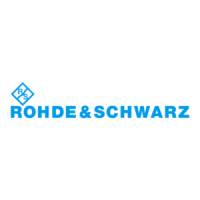Performing measurements
R&S
®
ZNA
64Getting Started 1178.6456.02 ─ 18
The R&S ZNA automatically adjusts its internal source and receiver to the selected
measured quantities: For an S
21
measurement, a stimulus signal (termed a
1
) is trans-
mitted at the analyzer port no. 1; the transmitted wave (termed b
2
) is measured at port
2. The stimulus signal from the analyzer port no. 2 is not needed except for some cali-
bration types.
By default the sweep range is set to the frequency range of the analyzer, which can be
unsuitable for your DUT. The following procedure shows you how to configure a
smaller sweep range.
1. Select Stimulus – [Start] and set the "Start Frequency" to the lowest frequency you
want to measure (e.g. 1.77 GHz).
2. In the "Stop Frequency" input field, enter the highest frequency you want to mea-
sure (e.g. 2.5 GHz).
3. Select Trace – [Scale] > "Scale Values" and activate the "Auto Scale Trace" func-
tion. The analyzer adjusts the scale of the diagram to fit in the entire S
21
trace,
leaving an appropriate display margin.
Tip: Refer to Chapter 5.7, "Scaling diagrams", on page 55 to learn more about the
different methods and tools for diagram scaling.
6.1.3 Calibrating the instrument
Calibration (system error correction) is the process of eliminating systematic, reprodu-
cible errors from the measurement results. E.g., in the current test setup, the connect-
ing cables between the analyzer ports and the DUT introduce an attenuation and a
phase shift of the waves. Both effects impair the accuracy of the S-parameter mea-
surement.
The analyzer provides a wide range of sophisticated calibration methods for all types of
measurements. The calibration method to select depends on the expected system
errors, the accuracy requirements of the measurement, on the test setup and on the
types of calibration standards available.
The following example requires a calibration kit with a male Through standard with
known transmission characteristics for the related test port connector type and gender.
With a single Through, it is possible to perform a transmission normalization, compen-
sating for a frequency-dependent attenuation and phase shift in the signal paths.
Transmission S-parameter measurement

